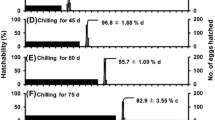Abstract
Egg diapause is found in a variety of insect orders and can occur in various stages, ranging from an early small germ band stage to a later stage in which an embryo exhibits appendages. Embryonic diapause is especially prominent in crickets inhabiting temperate regions, such as the band-legged ground cricket, Dianemobius nigrofasciatus. This species is common in the Japanese islands and exhibits a univoltine life cycle with obligatory egg diapause in northern regions, whereas a bivoltine life cycle with facultative egg diapause controlled by parental photoperiod and temperature is present in the southern regions. D. nigrofasciatus enters diapause during an early embryonic stage. Here we review the morphological aspects of early embryogenesis and how they relate to the various stages of diapause. By focusing on details of development, such as patterns of nuclear arrangement and the appearance of cell membranes, we can identify useful hallmarks for the study of diapause. In particular, the formation of a continuous thin layer of cells covering the egg’s surface normally reveals the formation of the cellular blastoderm. In diapause eggs, however, that continuous layer of cells covers the interior egg surface without forming a germ band, indicating that diapause occurs at the cellular blastoderm stage. Furthermore, in a bivoltine strain, diapause can be induced by low temperatures and averted by high temperatures applied to the eggs just before formation of the cellular blastoderm. In conclusion, diapause in D. nigrofasciatus entails developmental arrest at the cellular blastoderm stage, which can be influenced by temperature before blastoderm formation.
Access this chapter
Tax calculation will be finalised at checkout
Purchases are for personal use only
Similar content being viewed by others
References
Ando Y (2004) Egg diapause and seasonal adaptations in rice grasshoppers. In: Tanaka S, Higaki M, Kotaki T (eds) Insect diapause: mechanisms and evolution. Tokai University Press, Hatano, pp 4–15 (in Japanese)
Benton MA, Akam M, Pavlopoulos A (2013) Cell and tissue dynamics during Tribolium embryogenesis revealed by versatile fluorescence labeling approaches. Development 140:3210–3220
Danks HV (1987) Insect dormancy: an ecological perspective. Biological Survey of Canada, Ottawa
Fukumoto E, Numata H, Shiga S (2006) Effects of temperature of adults and eggs on the induction of embryonic diapause in the band-legged ground cricket, Dianemobius nigrofasciatus. Physiol Entomol 31:211–217
Ho K, Dunin-Borkowski OM, Akam M (1997) Cellularization in locust embryos occurs before blastoderm formation. Development 124:2761–2768
Ingrisch S (1984) Embryonic development of Decticus verrucivorus (Orthoptera: Tettigoniidae). Entomol Gen 10:1–9
Masaki S (1960) Thermal relations of diapause in the eggs of certain crickets (Orthoptera; Gryllidae). Bull Fac Agric Hirosaki Univ 6:5–20
Masaki S (1972) Climatic adaptation and photoperiodic response in the band-legged ground cricket. Evolution 26:587–600
Masaki S (1986) Significance of ovipositor length in life cycle adaptations of crickets. In: Taylor F, Karban R (eds) The evolution of insect life cycles. Springer, New York, pp 20–34
Masaki S, Walker TJ (1987) Cricket life cycles. In: Hecht MK, Wallace B, Prance GT (eds) Evolutionary biology, vol 21. Plenum, New York, pp 349–423
Mlodzik M, Fjose A, Gehring WJ (1985) Isolation of caudal, a Drosophila homeo box-containing gene with maternal expression, whose transcripts form a concentration gradient at the pre-blastoderm stage. EMBO J 4:2961–2969
Philogène BJR, McNeil JN (1984) The influence of light on the non-diapause related aspects of development and reproduction in insects. Photochem Photobiol 40:753–761
Sander K, Gutzeit HO, Jäckle H (1985) Insect embryogenesis: morphology, physiology, genetical and molecular aspects. In: Kerkut GA, Gilbert LI (eds) Comprehensive insect physiology biochemistry and pharmacology, vol 1. Pergamon, Oxford, pp 319–385
Sarashina I, Mito T, Saito M, Uneme H, Miyawaki K, Shinmyo Y, Ohuchi H, Noji S (2005) Location of micropyles and early embryonic development of the two-spotted cricket Gryllus bimaculatus (Insecta, Orthoptera). Dev Growth Differ 47:99–108
Shiga S, Numata H (1997) Seasonal changes in the incidence of embryonic diapause in the band-legged ground cricket, Dianemobius nigrofasciatus. Zool Sci 14:1015–1018
Slifer EH (1932) Insect development. IV. External morphology of grasshopper embryos of known age and with a known temperature history. J Morph 53:1–21
Tanaka H (1994) Embryonic diapause and life cycle in the migratory locust, Locusta migratoria L. (Orthoptera: Acrididae). Appl Entomol Zool 29:179–191
Tanigawa N, Matsumoto K, Yasuyama K, Numata H, Shiga S (2009) Early embryonic development and diapause stage in the band-legged ground cricket Dianemobius nigrofasciatus. Dev Genes Evol 219:589–596
Umeya Y (1950) Studies on embryonic hibernation and diapause in insects. Proc Jpn Acad 26:1–9
Wardhaugh KG (1986) Diapause strategies in the Australian plague locust (Chortoicetes terminifera Walker). In: Taylor F, Karban R (eds) The evolution of insect life cycles. Springer, New York, pp 89–104
Author information
Authors and Affiliations
Corresponding author
Editor information
Editors and Affiliations
Rights and permissions
Copyright information
© 2017 Springer Japan KK
About this chapter
Cite this chapter
Shiga, S., Numata, H. (2017). An Early Embryonic Diapause Stage and Developmental Plasticity in the Band-Legged Ground Cricket Dianemobius nigrofasciatus . In: Horch, H., Mito, T., Popadić, A., Ohuchi, H., Noji, S. (eds) The Cricket as a Model Organism. Springer, Tokyo. https://doi.org/10.1007/978-4-431-56478-2_5
Download citation
DOI: https://doi.org/10.1007/978-4-431-56478-2_5
Published:
Publisher Name: Springer, Tokyo
Print ISBN: 978-4-431-56476-8
Online ISBN: 978-4-431-56478-2
eBook Packages: Biomedical and Life SciencesBiomedical and Life Sciences (R0)




